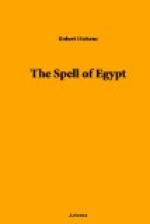Yet the crocodile god had a noble temple at Kom Ombos, a temple which dates from the times of the Ptolemies, though there was a temple in earlier days which has now disappeared. Its situation is splendid. It stands high above the Nile, and close to the river, on a terrace which has recently been constructed to save it from the encroachments of the water. And it looks down upon a view which is exquisite in the clear light of early morning. On the right, and far off, is a delicious pink bareness of distant flats and hills. Opposite there is a flood of verdure and of trees going to mountains, a spit of sand where is an inlet of the river, with a crowd of native boats, perhaps waiting for a wind. On the left is the big bend of the Nile, singularly beautiful, almost voluptuous in form, and girdled with a radiant green of crops, with palm-trees, and again the distant hills. Sebek was well advised to have his temples here and in the glorious Fayum, that land flowing with milk and honey, where the air is full of the voices of the flocks and herds, and alive with the wild pigeons; where the sweet sugar-cane towers up in fairy forests, the beloved home of the jackal; where the green corn waves to the horizon, and the runlets of water make a maze of silver threads carrying life and its happy murmur through all the vast oasis.
At the guardian’s gate by which you go in there sits not a watch dog, nor yet a crocodile, but a watch cat, small, but very determined, and very attentive to its duties, and neatly carved in stone. You try to look like a crocodile-worshipper. It is deceived, and lets you pass. And you are alone with the growing morning and Kom Ombos.
I was never taken, caught up into an atmosphere, in Kom Ombos. I examined it with interest, but I did not feel a spell. Its grandeur is great, but it did not affect me as did the grandeur of Karnak. Its nobility cannot be questioned, but I did not stilly rejoice in it, as in the nobility of Luxor, or the free splendor of the Ramesseum.
The oldest thing at Kom Ombos is a gateway of sandstone placed there by Thothmes III. as a tribute to Sebek. The great temple is of a warm-brown color, a very rich and particularly beautiful brown, that soothes and almost comforts the eyes that have been for many days boldly assaulted by the sun. Upon the terrace platform above the river you face a low and ruined wall, on which there are some lively reliefs, beyond which is a large, open court containing a quantity of stunted, once big columns standing on big bases. Immediately before you the temple towers up, very gigantic, very majestic, with a stone pavement, walls on which still remain some traces of paintings, and really grand columns, enormous in size and in good formation. There are fine architraves, and some bits of roofing, but the greater part is open to the air. Through a doorway is a second hall containing columns much less noble, and beyond this one walks




